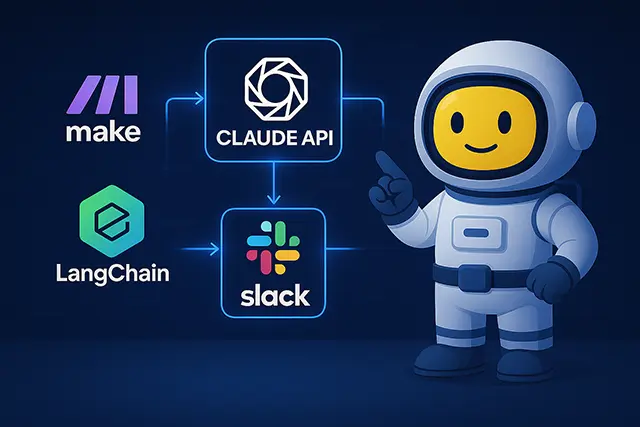Best Claude 4 Tools and Platforms for Real-World Automation

Forget flashy dashboards or AI buzzwords. when it comes to real-world automation, Claude 4 quietly powers some of the most effective systems today. Whether you’re an engineer fixing internal workflows or a product manager building feedback loops, Claude 4 tools are helping teams work smarter, not harder.
If you’re still wrapping your head around how Claude 4 works, take a look at our Claude 4 by Anthropic primer first. It breaks down the foundations: why Claude’s architecture is different, how its massive context window works, and why that matters.
But this guide is all about what comes after you get Claude. It’s about the tools that unlock it. We’re diving into Make.com, LangChain, Slackbots, API wrappers, and more all aimed at turning Claude from “just another LLM” into a real automation layer for your stack.
We’ll look at no-code platforms like Make.com, low-code solutions like Zapier, and advanced toolchains like LangChain and Pinecone. Whether you’re running on scripts or orchestrating flows in production, there’s a Claude-powered setup that fits your speed.
Table of Contents
Claude 4 Tools with Make.com: No-Code Workflows That Just Work
If your dev team is swamped or nonexistent Make.com offers a visual way to bring Claude into play. Their scenario editor lets you build workflows that respond to form inputs, spreadsheet changes, or file uploads then use Claude to summarize, classify, or respond.
Let’s say you receive 100 pieces of customer feedback per day. Claude can read those entries, pull key pain points, and send digestible summaries to your product or support teams.
Example Workflow:
- Trigger: New feedback added to Google Sheets
- Claude Task: Summarize sentiment, flag recurring issues
- Output: Digest sent to Gmail or posted in Slack
No Python, no servers. Just plug, configure, and run. If you’re curious how Claude handles tone or messaging, our guide on Claude 4 for Writers dives deeper.
Building Smart Slackbots with Claude 4
You’ve seen bots. But Claude-powered Slackbots? They’re on another level. Think HR assistants that know policy nuances. Or dev helpers that fetch docs and explain build failures all without feeling like canned scripts.
Popular Slackbot Use Cases:
- HR Support: Answers policy questions and benefits info
- Engineering Assistant: Responds to dev-related queries, shares Git repo links
- Onboarding Bot: Guides new hires through tools and docs
Typical Setup:
- Slack App listens for inputs
- Lightweight backend (Node.js / Flask) forwards prompt to Claude
- Response delivered directly in Slack, contextual to the channel
Claude’s tone control and memory prompt styles make it especially suited for human-like conversations just make sure to sanitize inputs and keep channel-specific limits in place.
Going Deeper with LangChain, Pinecone, and Vector Retrieval
When basic prompts aren’t enough, you’ll want a system that thinks with context. That’s where LangChain + Claude + a vector DB like Pinecone shines.
Why This Stack Matters:
- LangChain sequences actions: retrieval → summarization → reply
- Pinecone enables fast vector-based lookup from embedded documents
- Claude handles final reasoning + structured output
This is ideal for building internal knowledge bots, legal assistants, and document-heavy workflows where answers must be grounded in real content.
Claude API for Backend Logic
Need more control? Claude 4’s API lets you embed it directly into microservices. You format the data, set the context, and Claude returns usable outputs tags, summaries, decisions which then flow into your CRM, logs, or dashboards.
Backend Use Cases:
- Auto-prioritize incoming tickets
- Summarize Zoom meeting transcripts
- Enrich CRM records from messy text input
If latency or scaling matters, treat Claude as a smart function in your pipeline. Just be sure to manage token usage with prompt templates and caching.
Low-Code Options: Zapier, Pipedream, n8n
If Make.com feels too restrictive but APIs too complex, you’ll like the middle ground. Tools like Zapier, Pipedream, and n8n let you use Claude through HTTP calls without spinning up full backend infra.
Use them to:
- Clean up and rewrite form inputs
- Generate follow-up messages from survey answers
- Add Claude-powered summaries to Slack, Notion, or Airtable
Prompt Engineering Tips for Claude-Powered Workflows
Getting the most out of Claude 4 means crafting inputs that give you precision, context, and tone control. Prompt engineering is more than phrasing it’s architecture.
Effective Claude prompt tips:
- Always provide context in the system message: “You are a legal assistant” or “You are summarizing a customer call”
- Use delimiters like
###to clearly separate instructions and content - Chain-of-thought prompting: guide Claude through reasoning steps (great for logic or explanation prompts)
use case: For example, prompting Claude to “Extract all negative sentiment related to pricing” is far more useful than just “Summarize this.”
Common prompt engineering patterns:
- Structured JSON output formatting for easy parsing
- Persona prompts for tone: “Friendly marketing copywriter” or “Direct technical support agent”
- Few-shot examples to establish style
These techniques dramatically improve Claude’s reliability in tools like Make.com, LangChain, or even plain API calls.
Security, Rate Limits, and Compliance Considerations
If you’re deploying Claude-powered automations in production or inside corporate systems, security matters.
Claude 4 security tips:
- Sanitize all user input to prevent prompt injection (especially in Slack or public forms)
- Use Claude’s built-in token limits and control max response length
- Store logs securely Claude’s outputs can contain sensitive info
Rate limits and infrastructure:
- Claude 4 API has request-per-minute caps depending on your plan always implement retries with backoff
- Cache common queries or summaries to reduce API hits
Compliance and privacy:
- Claude doesn’t retain your data, but if you’re storing Claude output, make sure it complies with GDPR or HIPAA where applicable
- Use Claude’s API in secure environments only avoid exposing keys in client-side apps
For deeper control and governance, consider wrapping Claude’s API in your own middleware layer with logging, auth, and role-based prompt templates.
Choosing the Right Claude Tool Stack
Your ideal setup depends on who’s building it and for what. Here’s a cheat sheet:
| Use Case | Tool Stack | Code Level | Best For |
|---|---|---|---|
| Internal ops | Make.com + Claude | No code | Quick builds, non-dev teams |
| Team assistants | Slackbot + Claude API | Semi code | Humanlike chat, channel-specific |
| Knowledge retrieval | LangChain + Claude + Pinecone | Full code | Grounded answers, RAG systems |
| Backend processing | Claude API | Full code | Structured, event-driven output |
| Low-code automation | Zapier / n8n + Claude | Low code | Lightweight, modular flows |
Still unsure which route to go? Check out Claude 4 for Business Automation to explore how different teams are using Claude right now.
Final Thoughts
Claude 4 isn’t just a chatbot. It’s infrastructure flexible, secure, and getting smarter with each integration.
Start with no-code. Scale with APIs. Add vector retrieval when you’re ready. And if you’re still evaluating Claude, don’t miss our in-depth Claude 4 vs Gemini vs GPT-4 comparison.
No matter where you plug it in, Claude doesn’t just automate. It adapts.



